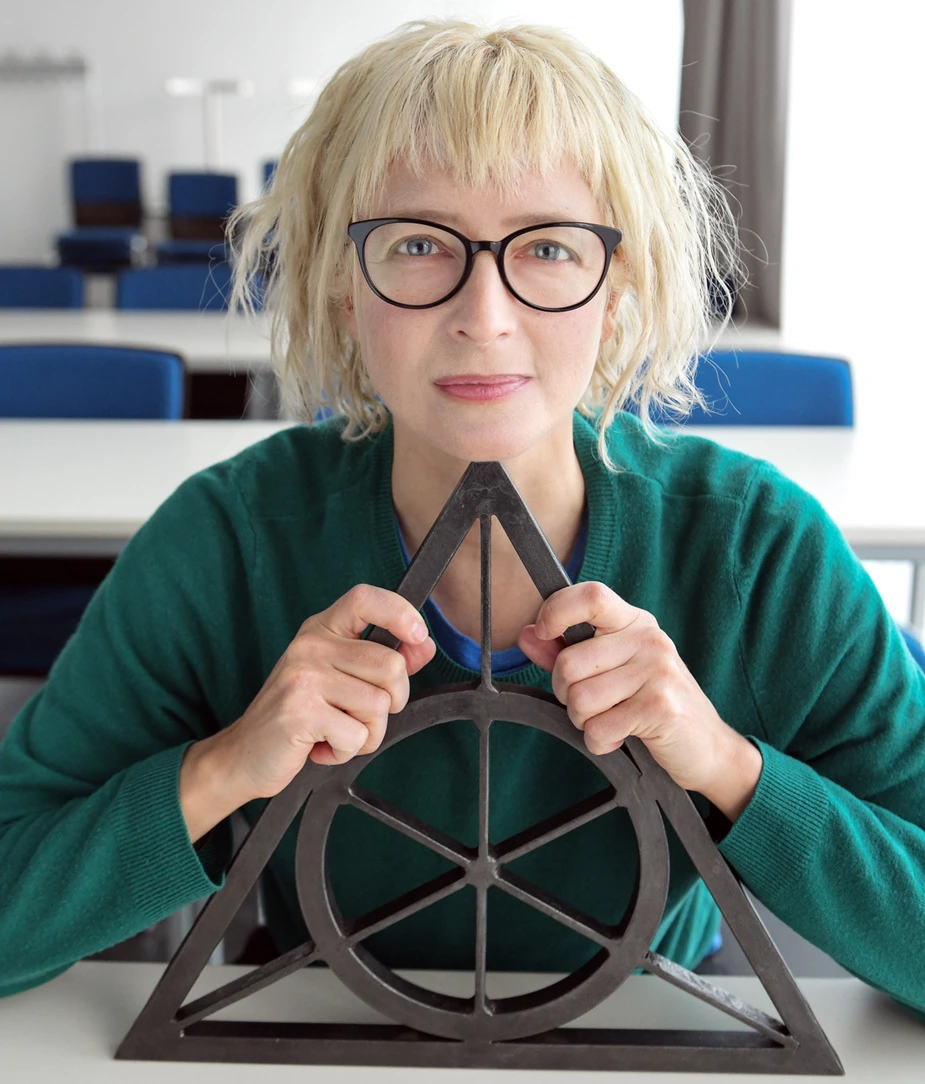The octave magician
Nichol (Cohl) Furey is a researcher at IRIS Adlershof
Does the word octave sound like music to your ears? For Cohl Furey, it is also full of mathematics. It was love at first sight when the physicist encountered the eponymous, eight-dimensional number system during her studies. And she suspects that it had a deeper meaning than just being a number. Like only a few researchers before her, she set out to find connections to the world of elementary particles – electrons, neutrinos, quarks – and their interactions, which are the basic building blocks of atoms and thus of our material world. Six months ago, the Canadian came to IRIS Adlershof at Humboldt-Universität zu Berlin for this purpose, financed for six years by a Freigeist scholarship from the Volkswagen Foundation. And it is hard to imagine a more suitable candidate.
“We are asking ourselves what is possibly the ultimate question: what is nature – at its most basic level?” says Furey. “Sometimes I feel as though this question is the only thing that matters.”
She was fascinated by elementary particles when she was at school. Especially by the fact that it has not yet been possible to unite all four forces that act between them in a theoretical model (a unified theory).
While other physicists use huge particle accelerators to search for ever new particles to complete the big puzzle, Furey wants to find the solution purely by thinking – in the world of numbers. This is where some believe, the natural origin of physics lies.
The octaves are the fourth and demonstrably last level of a special set of number systems that is successively built up from the real numbers. A physical interpretation has already been found for the first three: The real numbers we deal with in daily life and which we represent as a one-dimensional number line from minus to plus infinity describe the world as we perceive it. The two-dimensional complex numbers, which can be imagined from two real numbers as located in an x-y coordinate system, form the basis for quantum mechanics. The four-dimensional quaternions composed of them are the framework for Einstein's special theory of relativity. But the final eight-dimensional octaves should be of no significance? That didn't make sense to Furey either.
She set to work, incorporating an early result of Murat Günaydin from the 1970s. When, towards the end of her studies, she presented him an octave model of the strong and electromagnetic interaction, he nevertheless advised her not to pursue the topic any further. It was too unusual and therefore probably not conducive to a scientific career. But Furey was not deterred. She planned to earn the necessary money as a street musician if need be. So far, that has not been necessary. After her successful doctorate, she found a post-doctoral position in Cambridge. The three and a half years in the time-honoured British metropolis of science brought her decisive new impulses, not only from a professional point of view, thanks to the exchange with pure mathematicians. “Cambridge is timeless. With its maintained traditions, it is possible to experience firsthand many ways of life from centuries ago,” Furey finds.
She encountered a completely different world of life and research in Cape Town, where she spent three months at the African Institute for Mathematical Sciences. A city full of contrasts: “I loved Cape Town; it has a surreal beauty unlike any other place I’ve seen, and the people were fun … sadly it has still not outgrown the scars of Apartheid,” she says. “The students at AIMS were perhaps the hardest working I’ve seen. They worked every day with very few breaks, and often until two o’clock in the morning.”
As for the octaves, she has since managed to find more connections to the particle world. For example, quarks and leptons come in three copies. But why? Why not in two or a hundred? So far, this can be explained neither physically nor mathematically. However for low energies, by forming chains of octaves, Furey found such triple structures naturally.
At IRIS Adlershof, she wants to turn her attention to the foundations of quantum field theory. “Humboldt University has some of the world’s experts in this area, including Professors Dirk Kreimer, Jan Plefka, and Matthias Staudacher. I am looking forward to working alongside them,” emphasizes Furey, who also wants to build up her own research group.
She also feels very much at home in Berlin itself – one of her dream cities: “Even in the midst of a pandemic, there is rarely a day that goes by that I haven’t witnessed something completely eccentric. From 2-metre-tall unicycles, to face tattoos, to someone bringing their donkey to Tempelhofer Feld.”
She herself loves to learn new things in her free time as well. For example, playing instruments like the accordion or banjo ukulele. She has also taken her training in mixed martial arts to the city's green spaces in the days of the pandemic. She has been practising mixed martial arts from a young age – and is happy about the many curious looks from children: “There’s nothing I love more than the idea that I have burned a lasting image in their young minds: here’s what women do.”
The wiry, almost a little mystical appearance of the early forties-year-old with the grey-blond half-length hair also leaves an impression as a wanderer between worlds: between body and mind, the cultural attractions of very different cities and the overwhelming nature of South Africa. And not least between the musical, mathematical and physical sounds of the octaves.
By the way, colleagues at MIT have now started searching for a unified theory using artificial intelligence. Furey warns, “Perhaps we humans had better hurry.”
By Dr. Uta Deffke for Adlershof Journal
